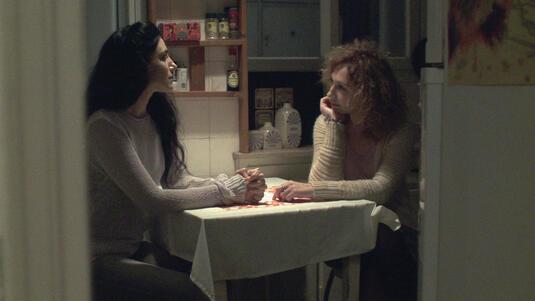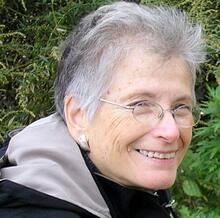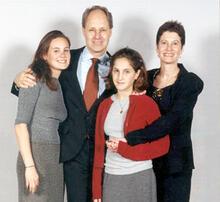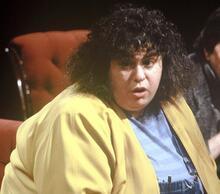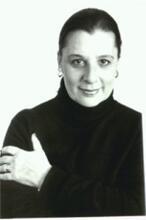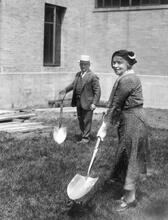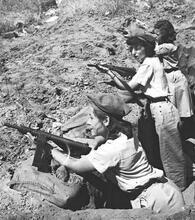Women in Israeli Cinema
For many years, women played a secondary role in Israeli cinema, with little voice of their own and limited largely to objects of the male gaze. More recently, through the work of female filmmakers, portrayals of women have moved from objectification to complex human representation and female characters have been freed from masochistic patriarchal constraints. Following the emergence of women filmmakers, who often emphasize autobiographical narratives, representation of Israeli women has finally reached a point where it can authentically criticize the earlier cinematic representation that marginalized them and their personal narratives and find new ways to use cinema as a tool for empowerment.
Traditional representations
More than a century ago, Zionist ideology promoted visions of a brave new world that was to be finally re-established in the Promised Land. One of these visions was the equality of men and women, regardless of the physical effort involved in their work. Women were not to be spared any effort; on the contrary, their experiences soon became a model for the liberated gender norms of women engaging in the new egalitarian world.
Pre-State cinema took an active role in forming this ideal representation and portrayed women as physically involved in building this new world, either carrying weapons or working the land. However, looking back at the history of Israeli cinema—and of Zionism in general—we realize that women were not in fact given the role that they deserved and that was in theory being offered to them. While being used to promote the progressive image of Israel that was to become emblematic of Zionism, the female pioneers were in fact doomed to despair and loneliness, as described in Michal Aviad’s powerful documentary The Women Pioneers (2013), based on the diaries of women pioneers who emigrated from Europe to Palestine at the turn of the previous century.
This article reviews the evolution of women in Israeli cinema, in front of and behind the camera. It took Israeli women years until they moved behind the camera and decided how they wanted to be represented. Even then, their self-depiction was not easily accepted and only recently has Israeli cinema begun to create new forms of feminine representation, revolving around complex subjective narratives focusing on Israeli women’s lives and what makes them so distinctive.
In contrast to Hollywood cinematic industry, early Israeli cinema did not pay much attention to women’s attractiveness. However, it did use all the existing cinematic apparatus—especially close ups of their intimate parts—to emphasize women’s sexuality. Early Israeli films also often limited women’s occupations to either housewife or prostitution. Filmmakers such as the legendary Menachem Golan established their reputations by telling the adventures of fallen women subsisting in Israel’s backyard, most often in Israel’s development towns. Golan released a series of feature films revolving around female characters—Dalia and the Sailors (Daliah VeHamalachim, 1964), Fortuna (1966), and The Highway Queen (Malkat HaKvish, 1970)—all emphasizing the sensual character of Israeli women. Following the international success of Golan’s films a few Israeli actresses were invited to play minor roles overseas but generally did not develop international careers.
Women in early Israeli cinema were generally considered as irrelevant. They were seen as part of nature, like sand, trees, and animals. Although they sometimes spoke and expressed their opinions on unimportant matters, they did not represent the core of the narrative and were subordinated to other major issues on the Israeli agenda, such as the military or the Israeli melting pot. Accordingly, women did not appear as fully formed characters in the first Israeli films (either feature or documentary films); even when a film bore a feminine name in its title, such as Fortuna (directed by Menahem Golan, 1966) or Sarit (directed by George Ovadia, 1974), the title did not indicate that the narrative referred to these characters' subjectivity, for the female character's sole purpose was to comply with the sentimental atmosphere that, by definition, addressed women's deviation from, and reintegration into, the patriarchal order.
This instrumental use of women in film lasted for many years, with one exception: Ellida Geira's Before Tomorrow (Lifnei Mahar, 1969), which used the new modernistic cinematic language of the Israeli "New Sensibility" movement (inspired by the 1960s French New Wave) to examine Israeli women's cultural and social circumstances. Before Tomorrow is composed of two short films in which women act as subjects. In the first, entitled “Spring,” we follow a young couple falling in love without any dialogue in the soundtrack, as in a silent film. The second part, entitled “Fall,” is a comedic love story in which a lonely old Jewish lady falls in love with a lonely old Iraqi falafel vendor. Before Tomorrow was an exception to the local misogynist cinema, and Geira was invited to the Cannes Film Festival to present her work. One might expect that after such an achievement, Israeli cinema would become more oriented towards women, but such a change did not occur immediately. Indeed, during the 1970s, extremely sadistic representations of women became part of Israeli cinema—including the famous rape scene of actress Gila Almagor in Menahem Golan’s Queen of the Road (Malkat Hakvish, 1970).
First shifts in representation
Only in the late 1970s, after years of oppression and misrepresentation, did Israeli women filmmakers begin to make their own movies, in the hopes of creating radical change in the modes of representation. The change began by giving women characters biographies—fathers and mothers, siblings, and places of birth. Their identity was no longer defined by their positions inside the family order, but rather by themselves and their ways of recounting their stories. Consequently, the narratives engaged with issues that influence women’s lives, such as mother-daughter relations, women's ability to control and transform their destinies, and their attempts at pursuing their dreams.
This shift in representation was accomplished by women who acted both behind and in front of the camera, directing and playing the leading roles in their own films. The first woman to achieve this tour-de-force was Michal Bat Adam, who wrote and directed Moments (Rega'im, 1979), which describes the friendship between two young women, a French tourist named Anne and an Israeli writer named Yola (played by Bat Adam), against the backdrop of the city of Jerusalem. Bat Adam's film featured female characters who differed from previous portrayals of women; its narrative revolved around personal issues and specific feminine affinities, rejecting the intense national concerns that preoccupied Israeli cinema at the time, namely the impact of the 1973 Yom Kippur war on future Israeli generations. However, toward its end, when Yola's boyfriend returns from his military reserve service, the film presents the two women in a voyeuristic threesome love scene—a plot device that reminds us that the feminist revolution had not yet reached Israeli cinema, and that a woman filmmaker was still obliged to cater to the male audience. Despite this unfortunate choice, Bat Adam's film remains a turning point in Israeli cinema's gender representation, as it presented, for the first time, a friendship between two women—a theme that until then had been limited to the camaraderie between men (generally of a military background). Bat Adam's next films, A Thin Line (Al Chevel Dak, 1980) and Boy Meets Girl (Ben Loke'ah Bat, 1982), focus on autobiographical narratives concerning her childhood in the kibbutz and her ailing mother. This autobiographical trend became an identifying feature not only of most of Bat Adam's later films, but also of Israeli women’s filmmaking in general. Bat Adam remains the most prolific Israeli women director, with thirteen feature films as of 2019, the latest of which was The Road to Where (HaDerech Le'an, 2016).
Bat Adam was followed by other women filmmakers, but few achieved the same impact. A noteworthy exception was Orna Ben-Dor’s important documentary Because of That War (Biglal HaMilchama HaHi, 1988), which did not engage with feminist issues but marked an atypical step in Israeli filmmaking in general. It turned a compassionate eye on two very popular Israeli singers of the time, Yehuda Poliker and Ya’akov Gilad, and revealed their personal histories as second-generation Holocaust survivors. Even during the fourth decade of Israel’s independence, this was a taboo that few dared break. Only Ben-Dor, a woman filmmaker who identified with the complexity of their identity issues, could come close to the protagonists and reveal their story.
Throughout the 1980s, women continued to be portrayed largely stereotypically, as either devoted wives or prostitutes. A different kind of representation was found in Daniel Wachsmann's Eastern Wind (Hamsin, 1982), in which a young woman (actress Hemda Levi), who lives on a farm in Galilee with her brother, dares break unwritten racial and social laws by establishing a romantic relationship with a young Arab farm worker—a transgression that leads to a catastrophic ending. Although the main character is neither a wife nor a prostitute, like other films of this decade, women are still represented through the depiction of a sexual act. In the same spirit, Yaky Yosha's Dead End Street (Kvish L'Lo Motzah, 1982) was intended to reveal the media’s hypocrisy. In this film, a young prostitute (actress Anat Atzmon, who became a star after her debut in 1978's Lemon Popsicle [Eskimo Limon]), is adopted by a bourgeois couple from Tel Aviv who plan to make a documentary about her life. As time passes, she discovers that the husband is sexually attracted to her. She is thus no longer considered a source of inspiration but rather a cause for trouble, and she is kicked out of the house, back to the streets to look for other clients. Here, again, the woman's naked body is very often exposed, apparently for no other reason than to provide pleasure to male viewers. This tendency recurs in many films throughout the 1980s, as the female body is exploited, often without any special reason.
Critique of the patriarchal family
One of the most important achievements of Israeli women’s cinema occurred with the release of Hana Azoulay-Hasfari’s film Sh’Chur (1994), directed in collaboration with her husband Shmulik Hasfari. This semi-autobiographical film aimed to undermine the debasing cinematic representation of Mizrahi women (Jews from Asia or North Africa) as not only illiterate but also promiscuous. More than any other film at the time, Sh'Chur (designating a specific form of Moroccan black magic) addressed the experience of surmounting the immigration hardships of a Moroccan youth, as opposed to the traditional biased depiction of Moroccan girls and women in Israeli comedies that enjoyed playing on the cultural and educational gaps between the Ashkenazim and the Mizrahim and Sepharadim).
Based on the filmmaker’s autobiography, Sh'Chur told the story of a decisive summer in the life of Rachel, the first Israeli-born (zabar) child of a large Moroccan family headed by an authoritarian blind father in southern Israel. During this summer Rachel experiences a coming of age in which she realizes women’s deprived role in her environment and their oppression by males both in their families and in the State’s authorities. At the end of this summer she is sent to a prestigious boarding school in Jerusalm that prepares her to be a successful Israeli television presenter. But all these achievements are suddenly challenged upon her father’s funeral, which leads her back to the poor village she left behind and forces her to acknowledge the impossible journey she achieved. Sh’Churled the way, followed by many other Mizrahi women's narratives, especially in Israeli fiction films. One of the filmmaker’s interesting choices was to opt for magical realism and the mixing of dreams and reality in scenes that reconstructed the young girl’s vision of her surroundings. But this uncommon feature mostly reflects the Moroccan black magic of the Sh’Chur that became symbolic of the heroine’s inescapable destiny.The filmmakers seem to suggest that this Moroccan family’s helplessness was surmountable thanks to their ancient magic and superstition that provided them with weapons against the State’s oppression.
The next groundbreaking film was Ronit Elkabetz's To Take a Wife (VeLakachta Lecha Isha, 2004), directed in collaboration with her brother Shlomi Elkabetz. Ronit Elkabetz also chose to play the leading role in this family drama, which was followed by The Seven Days (Shiv'a, 2009) and Gett: The Trial of Viviane Amsalem (Gett, 2014). Throughout this trilogy, the heroine Viviane Amsalem understands that she is a victim of her ancestral Mizrahi tradition, in which divorce is never an option. Set in the late 1970s in a remote Israeli town, To Take a Wife tells of the growing disappointment of Viviane, a mother of three who feels that she did not fulfill her dreams and is now imprisoned in a miserable marriage to a man who has no ambitions and who finds his comfort only among his male friends at the local synagogue. The sour feeling of missed opportunities accompanies the protagonist in her unhappy family life, and she decides to ask for a “get” (bill of divorce), which her husband refuses to give her. Similar to Sh'Chur, To Take a Wife is critical of the Mizrahi family, revealing the Mizrahi subjects’ tragedy of immigration in general and particularly that of the women who attempt to free themselves from the patriarchal system in which they were born.
The tragedy of Viviane Amsalem continues in The Seven Days, in which the whole family gathers following the death of the elder brother. The film is set during the Gulf War, and Viviane's husband Eliyahu still refuses to grant her a get. The week of the shiva (seven days of mourning) reveals that the entire family is being torn by the unbridgeable gap between their adherence to Jewish traditions and the adoption of new customs from secular Israeli life. In this respect, The Seven Days offers a wider viewpoint on the changing gender roles in patriarchal Mizrahi families, especially in regard to the loss of male familial authority following immigration and the pressure to forsake old habits.
The third film in the trilogy, Gett: The Trial of Viviane Amsalem, is set entirely in the rabbinical court. Fifteen years have passed since the events depicted in To Take a Wife, and Viviane has finally decided to address the court with the help of a lawyer who would plead her cause. However, the rabbinical court is not yet ready to acknowledge Viviane's case. The rabbinical judges argue that the fact that she does not love her husband cannot be considered a sufficient reason for divorce, especially in light of her husband's insistence that he wants to save their marriage. The whole film is shot in the confined space of the Jerusalem Rabbinical Court, and the various witnesses who enter this crowded room provide the drama. This cinematic strategy arouses a feeling of imprisonment, as if the characters are held captive by the rabbinical system with no possibility of escape. Following a series of testimonies from all of Viviane's family members, friends, and neighbors, the judges finally renounce the option of marital reconciliation (shalom ba'it in Hebrew) and rule in favor of Viviane: Eliyahu must grant his wife a divorce.
The Elkabetz trilogy represents a further step in Israeli women’s representation: working against the voyeuristic instinct of cinema, the lead actress Ronit Elkabetz undergoes a visual transformation, from a heavily made-up woman in the first film to appearing without any makeup at the rabbinical court, as if to allow the viewers to note the marks of the years that went by, the years she spent on her attempts to get her divorce. Ronit Elkabetz passed away shortly after the release of this film, leaving an immense void in Israeli cinema.
Revised perceptions of women's sexuality
Another prominent woman filmmaker in contemporary Israeli cinema is Keren Yedaya, whose films are a major contribution to the evolution of Israeli women’s image on the screen. Yedaya's debut film, Or, My Treasure (2004), won the 2004 Cannes Film Festival Camera D'Or for best debut film and received immediate international acclaim due to its flawless realistic style, combined with the exceptional performance of its two leading actresses, Ronit Elkabetz and Dana Ivgy. Or, My Treasure tells the story of a prostitute and her daughter, Or, and depicts the tender relationship between mother and daughter and the daughter's desperate attempt to save her mother from prostitution. The film courageously examines the tragic dead end of prostitution and the impossibility of recovering from it. Or, My Treasure demonstrates that prostitution should not be seen ast a crime but rather as the social and economical outcome of a certain social constellation (in addition to the absence of a serious national welfare system). Though the ethnic origins of the leading characters is not mentioned, the actresses’ origins seem to provide an answer to the biased representational tendency of Mizrahi women that ruled since the beginning of Israeli cinema. Yedaya intentionally decides not to show the female protagonists (the prostitute and her daughter) in sexual acts and their characterization is limited to their dialogue. Doing so, she provides an alternative to Israeli cinema’s misogynistic tradition.
Yedaya's Or, My Treasure was followed by Jaffa (Kalat Hayam, 2009), an impossible love story between a young Israeli woman (also played by Dana Ivgy) and a Palestinian man. This theme, which gained popularity in the 1980s in Israeli political cinema with films such as Daniel Wachsmann’s Eastern Wind (Hamsin, 1982) and Nissim Dayan’s A Very Narrow Bridge (Gesher Tsar Meod, 1985), is set in Jaffa, where Jews and Arabs share the same tense space. Inspired by Egyptian melodrama, the film combines extreme close-ups on the faces of the protagonists with exceptionally dramatic music, typical of the melodramatic genre. Though the mother and daughter are portrayed by the same actresses as in Yedaya’s previous film (Elkabetz and Ivgy), their roles are extremely different: here the mother is cold and distant, with a clear reference to 1960s European cinema, and the daughter is fresh and innocent.
Yedaya's 2014 film, That Lovely Girl (Harcheck mi headro), dared touch on one of the most prominent cultural taboos: incest. It tells of a highly disturbing relationship between a father and daughter in an Israeli suburb, depicting her gradual realization that something is profoundly wrong and her attempts to escape. In this film, the female body plays an important role: because it is the father’s object of desire, it is often exposed on screen, but never in a pornographic or voyeuristic way. In spite of their immense dissimilarities, Yedaya's three feature films are to be considered as a trilogy, as their narratives retrace the numerous ways in which Israeli women are left unprotected due to the inedequacies of the national welfare system and therefore become easy prey, while cinematically demonstrating how even the crudest portrayals of women can and should avoid voyeurism.
The leading contemporary documentary filmmaker Michal Aviad has recently turned to feature filmmaking, and she quickly made an impact on the cinematic representations of women in Israel. Her first feature film, Invisible (Lo Roim Ala'ich, 2011), depicted a chance encounter between two young women (played by Ronit Elkabetz and Evgenia Dodina) who were raped in their youth by the same man, and their attempt to persuade the court to reconsider its sentencing of him. Based on a true story, the film combines documentary footage and reconstituted scenes in order to revive a terrible event from the past, but whose consequences can still be felt by the victims. Aviad bravely engaged with one of Israeli culture's taboos: the issue of sexual violence that was long considered non-existent. In the past, violent sexual acts were presented as "facts of life" and represented accordingly in Israeli films, such as Menachem Golan's Queen of the Road (1970). In Invisible, this violence is scrutinized, with the intention of shedding light on women's place in society, their pain, and the implications of these acts for them.
In 2018, Aviad released another feature film, Working Woman, about the subtle mechanisms that enable sexual harassment in the workplace, a topic whose importance is generally minimized in Israeli society. In this film, Aviad deconstructs the apparatus that fosters women's dependence on the capitalistic system and demonstrates the price they pay in order to take part in it.
New Directions
Another cardinal issue in Israeli women's cinema is the military. After its establishment, the State of Israel was proud of its women soldiers, who symbolized the egalitarian socialist system of Zionism, and Israeli cinema frequently portrayed this unique achievement. However, today's women’s cinema has become more critical of the military, especially regarding the role of young women. Some contemporary films criticize the expendability of female labor in the Israel Defense Forces, a direct consequence of compulsory military service; this was the premise of Talya Lavie's successful feature film Zero Motivation (Efes BeYachasei Enosh, 2014), which depicted a group of women soldiers who are forced to invest their time and energy on pointless tasks, only because they were required by law to enlist. Other films dare to explore important subjects such as gender equality in army units and in the allocation of duties. This issue is investigated in Tamar Yarom's documentary To See if I’m Smiling (Lir'ot Im Ani Mechayechet, 2007), which collects the testimonies of Israeli women soldiers who served in combat positions during the second Intifada (Palestinian uprising); in the film, it becomes apparent that all of these young women suffer from post traumatic stress disorder and regret their enthusiasm for joining male units.
Finally, Haredi, or ultra-Orthodox, women have recently begun to engage in filmmaking. Their films differ in many aspects from secular Israeli cinema, as they are first and foremost governed by the Jewish religious laws regarding modesty. Hence, in these movies the physical body is never an issue, except when it comes to birth and death. A pioneering film in this category is the American-born Israeli filmmaker Rama Burshtein’s debut film, Fill the Void (Lemaleh et ha-halal, 2012). It tells the story of Shira, a young Orthodox girl who must choose between her heart's desire and her duty towards her family. After her older sister's death, Shira is supposed to marry the widowed husband, who threatens to leave the country with his child. Torn between the Jewish ruling and her personal longings, Shira's dilemma reflects a larger domain of moral and ethical hesitations that Haredi women face. The film presents for the first time the complex world of the Haredi woman who has to resolve the contradictions between religion and personal desires. Michal, the protagonist of Burshtein's second feature film, The Wedding Plan (La'avor et HaKir, 2016), is an Orthodox Jew born into a secular family. Although her wedding engagement has been broken, Michal decides to continue planning her wedding, believing that God will send her a groom. The heroine’s determination to marry and not end up an old spinster—considered the worst curse in her community—brings her to an unexpected happy ending.
In addition to Burstein's feature films, a series of women’s documentaries were produced during the last decade, mostly in the framework of the religious Ma'aleh School of Television, Film and the Arts in Jerusalem. Among these filmmakers is Anat Zuria, who created a trilogy—Purity (Tehora, 2002), Sentenced to Marriage (Mekudeshet, 2004), and Black Bus (Soreret, 2010)—dealing with the constraints the Jewish religion imposed on women. Another example of this breakthrough in the cinematic representation of religious women is Neta Ariel’s most recent film, A Mirror for the Sun (HaMar'ah shel HaShemesh, 2018). The film focuses on Tamar Ariel, who grew up in a religious home and joined the IDF air force, where she served as the first Jewish Orthodox combat navigator. In 2014, Tamar Ariel traveled to Nepal, where she died in a snowstorm in the Himalayas.
To conclude, contemporary Israeli women’s cinema has initiated a significant battle against biased and sexist representations, and this battle, led by young women filmmakers, seems to be bearing fruit. The brave attempts of Israeli women filmmakers such as Michal Bat Adam, Hana Azulay-Hasfari, Ronit Elkabetz, and Keren Yedaya have had an immense influence on the representations of women in Israeli cinema and contributed to the feminization of Israeli cinema, the appearance of a new kind of sensitivity, uncharacteristic of the mythical sabra. More films made by women are constantly being released, offering an amended image of the Israeli "weaker sex." Based on a more complex image of female subjectivity, these representations that consciously avoid voyeurism, thus condemning it, seem to inspire the constitution of a better Israel that will no longer be ruled by chauvinistic conceptions.
Harris, Rachel. Warriors, Witches, Whores: Women in Israeli Cinema. Detroit : Wayne State University Press, 2018.
Lubin, Orly. Women Reading Women. Haifa : Haifa University Press, 2003. [Hebrew].
Munk, Yael. "Ethics and Responsibility: The Feminisation of the New Israeli Documentary." Israel Studies 16, no. 2 (summer 2011): 151-164.
Yosef, Raz. "Trauma, Ethnicity and Moral Responsibility: Mizrahi Women in Contemporary Israeli Cinema." MiKan 13 (September 2013): 106-123. [Hebrew].






